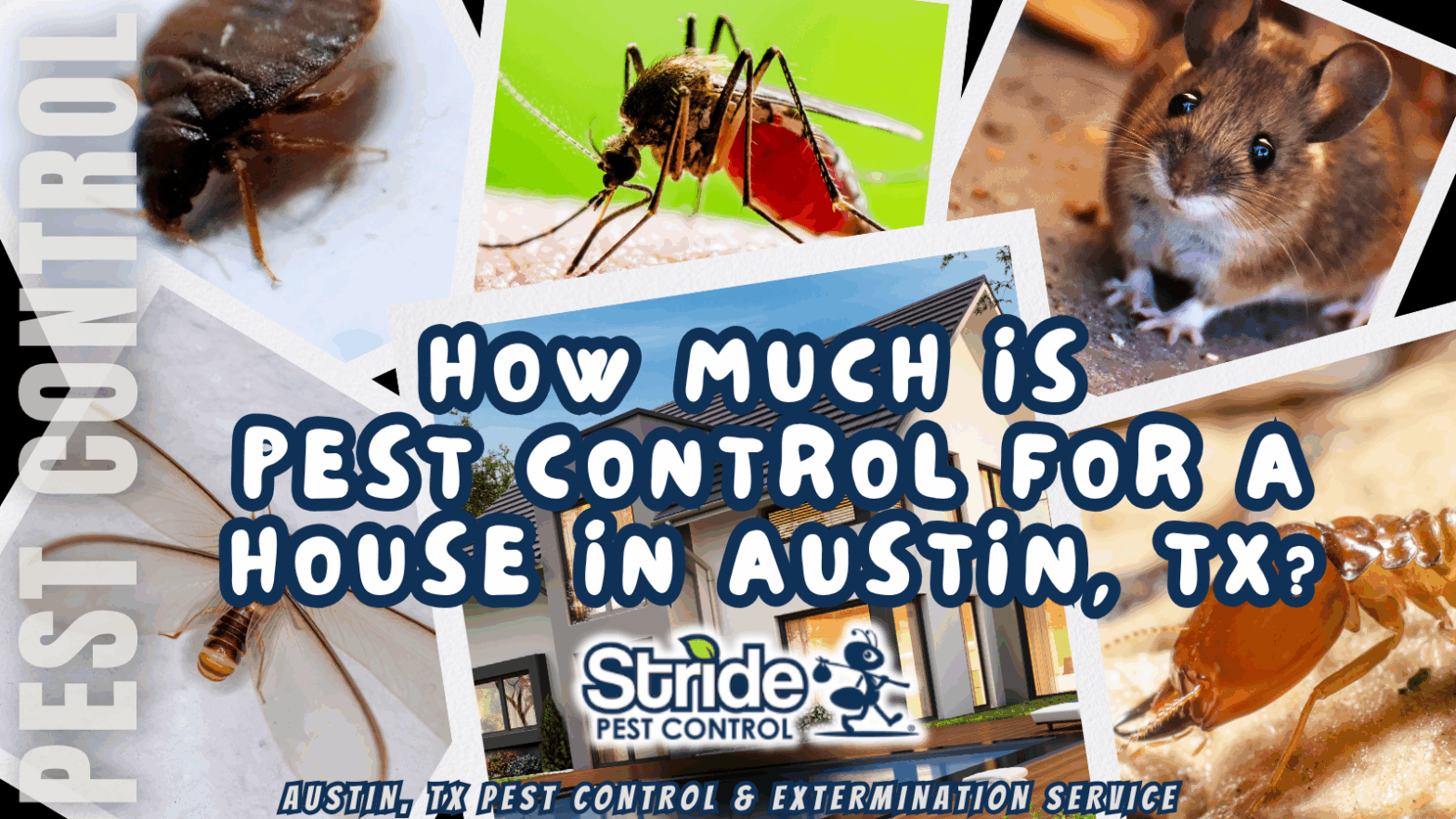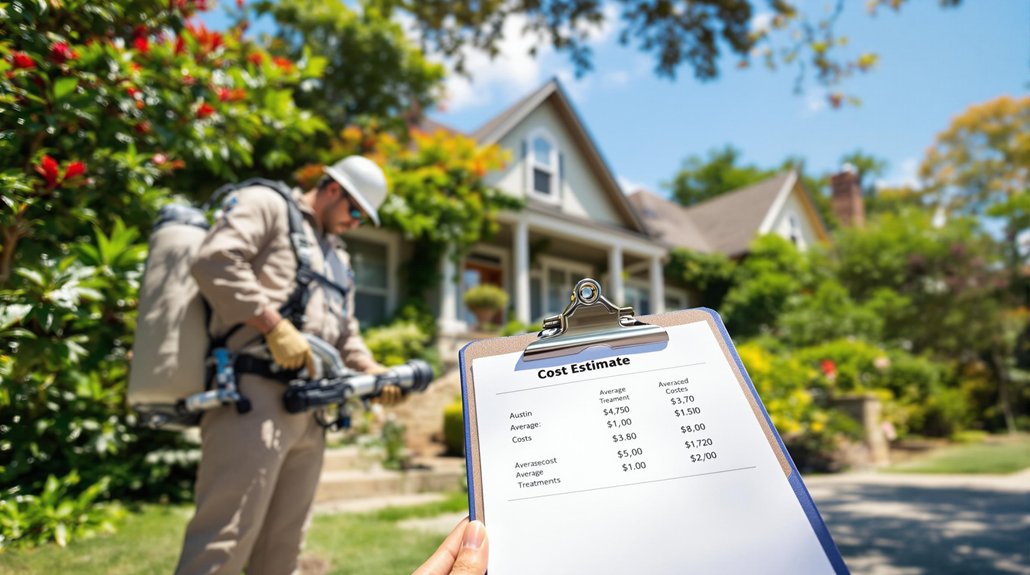
Pest control costs for houses in Austin typically range from $100 to $2,000, depending on factors like the pest type, infestation severity, and treatment method used. Eco-friendly options may cost between $100 and $300, while chemical treatments range from $150 to $400. For more severe infestations, such as termites or rodents, expenses can rise significantly. Partnering with a trusted Austin, Texas extermination company helps homeowners choose the most effective and affordable treatment plan. There is more to learn about pest control methods and maintenance options.
Key Article Highlights
- Average costs for eco-friendly pest control treatments in Austin range from $100 to $300 for initial services.
- Chemical pest treatments typically average between $150 and $400, providing quicker results.
- Termite treatments can vary significantly, costing between $500 and $2,000 depending on infestation severity.
- Rodent control services usually fall between $200 and $600, depending on the extent of the problem.
- Regular treatments every three months can help manage pest issues and reduce overall costs in the long run.
Understanding Pest Control Services
When homeowners encounter pest problems, understanding pest control services becomes essential. These services offer various pest control techniques to address issues effectively. Common techniques include baiting, trapping, and chemical treatments. Homeowners must select the right method based on the type of pest and the severity of the infestation. Pest management strategies focus on prevention and long-term solutions, often utilizing perimeter sprays to create a protective barrier. This can involve sealing entry points, maintaining cleanliness, and regular inspections. Effective pest control in Round Rock often includes residual sprays to target infestations directly. Professional pest control services often provide tailored plans to meet specific needs. By grasping these concepts, homeowners can make informed decisions and enhance their living environment. Ultimately, understanding pest control services empowers homeowners to manage and prevent future pest issues effectively. Additionally, Austin pest control employs integrated pest management to treat various pests through a combination of techniques.
Common Pest Problems in Austin Homes
Commonly, Austin homes face a variety of pest problems that can disrupt daily life. Effective pest prevention is vital to maintain a healthy living environment. The following table outlines some of the common pests found in Austin and their impact:
| Pest Type | Common Signs | Prevention Methods |
|---|---|---|
| Ants | Trails and nests | Keep food sealed |
| Cockroaches | Droppings and odor | Regular cleaning |
| Termites | Wood damage | Inspect wood structures |
| Spiders | Webs and sightings | Declutter spaces |
Addressing these common pests is essential for homeowners. Being proactive with pest prevention helps minimize infestations and maintain comfort in Austin homes. Additionally, implementing effective strategies for termite control and prevention can safeguard your property from potential damage. Regularly treating areas such as pet bedding and crawl spaces can significantly reduce the likelihood of infestations. To further enhance your pest management efforts, consider utilizing barrier sprays that can help create a protective shield around your home.
Average Costs of Pest Control Treatments

The average costs of pest control treatments can vary based on several factors. Different types of treatments have different price points, and the frequency of service can also affect overall costs. Additionally, prices may change depending on the location within Austin.
Treatment Type Costs
Pest control treatment costs in Austin can vary widely based on the type of service required. Understanding these costs helps homeowners make informed decisions.
- Eco Friendly Treatments: Typically range from $100 to $300 for initial services, focusing on natural solutions.
- Chemical Treatments: Average between $150 and $400, using synthetic products for rapid results.
- Termite Treatments: These can be more expensive, often costing $500 to $2,000 depending on the severity of the infestation.
- Rodent Control: Usually falls between $200 and $600, based on the extent of the problem.
Homeowners should consider their needs when choosing between eco-friendly and chemical treatments to find the best fit for their situation.
Frequency and Pricing
How often should homeowners schedule pest control treatments? Generally, frequency recommendations suggest treatments every three months for effective pest management. However, this may vary based on specific pest issues. Homeowners should consider their particular situation when determining the right schedule.
Pricing comparisons for pest control treatments in Austin typically range from $100 to $300 per visit, depending on the service type and home size. Some companies offer package deals for multiple treatments, which can provide savings over time. Homeowners should evaluate different service providers to find the best balance between frequency and cost. Regular treatments can prevent infestations and save on future expenses, making it a wise investment for maintaining a pest-free home.
Location-Based Variations
While costs for pest control treatments can vary considerably across different regions, homeowners in Austin typically encounter average prices that reflect the area’s unique pest challenges. Various location factors contribute to these costs, particularly the types of regional pests prevalent in the area. Understanding these factors helps homeowners prepare for expenses.
- Type of Pest: Different pests like termites or rodents may require specialized treatments.
- Severity of Infestation: A larger infestation can lead to higher costs.
- Treatment Frequency: Regular treatments may reduce overall costs in the long run.
- Service Provider: Prices can vary between local companies and national chains.
These factors play a significant role in determining pest control costs in Austin.
Factors Affecting Pest Control Pricing

Several factors can influence the pricing of pest control services. The type of pest being treated often affects costs, as some pests require more specialized methods. Additionally, the size of the property can impact the overall price, with larger areas typically needing more resources.
Type of Pest
The type of pest plays a significant role in determining pest control pricing. Different pests require specific treatments, influencing overall costs. Here are four common pest types and their impact on pricing:
- Bed Bugs: Treatment is often extensive, involving multiple visits and methods, leading to higher costs.
- Termite Control: This requires specialized techniques and materials, making it one of the more expensive pest control services.
- Rodent Issues: Addressing rodent problems includes traps and exclusion methods, affecting the total price.
- Ant Infestations: While generally less costly, they may still require repeated treatments for effective management.
Other pests like mosquitoes, spiders, cockroaches, wasps, and fleas also influence prices through specific pest identification and management strategies.
Property Size
Property size is a key factor in determining pest control pricing. Larger properties typically require more resources and time, which can increase costs. Home layout also plays a role; complex designs may need more effort to treat effectively. Understanding property dimensions helps homeowners estimate potential expenses.
| Property Size | Estimated Cost | Description |
|---|---|---|
| Small (up to 1,000 sq ft) | $75 – $150 | Simple layout, easy access |
| Medium (1,000 – 2,500 sq ft) | $150 – $300 | Moderate layout, some challenges |
| Large (2,500 – 4,000 sq ft) | $300 – $500 | Complex layout, more time required |
| Extra Large (over 4,000 sq ft) | $500+ | Extensive space, specialized services needed |
Types of Pest Control Methods
Pest control methods vary widely to address different infestations and environments. Understanding these methods helps homeowners choose the best approach for their needs. Here are four common pest control methods:
- Biological Control: This method uses natural predators or parasites to control pests. It is environmentally friendly and sustainable.
- Chemical Control: Involves using pesticides to eliminate pests quickly. While effective, it requires careful application to minimize risks.
- Cultural Control: This method focuses on changing habits and practices to reduce pest attraction. Examples include proper sanitation and crop rotation, as well as ensuring thorough sanitation recommendations to prevent rodent access.
- Mechanical Control: This involves physical barriers or traps to prevent pests from causing damage. It is often a low-risk option.
In addition, effective strategies such as heat treatment can be crucial for controlling specific pests like bed bugs, ensuring comprehensive management of infestations. Each method serves different purposes and should be considered based on the specific pest problem.
DIY Pest Control vs. Professional Services
While some homeowners may choose DIY pest control methods to save money, others prefer hiring professional services for their expertise. DIY methods often involve using readily available products and techniques that can be effective for minor pest issues. These methods may seem cheaper, but they require time and effort from the homeowner. On the other hand, professional services typically come with a higher cost but offer specialized knowledge and experience. Cost comparison between DIY and professional services often shows that while DIY might save money upfront, professional services can lead to better long-term results. Homeowners must evaluate their specific pest problems and decide which approach aligns with their budget and needs.
Importance of Regular Pest Control Maintenance
Maintaining a regular pest control schedule is essential for homeowners who want to protect their living spaces. Consistent pest control offers several advantages that contribute to a healthier home environment. The pest prevention benefits are vital for avoiding infestations before they occur. Additionally, regular treatments can lead to long term savings by preventing costly repairs and property damage.
Here are some key reasons to prioritize pest control maintenance:
- Reduces the risk of disease-carrying pests.
- Protects structural integrity by preventing infestations.
- Enhances comfort and quality of life at home.
- Saves money in the long run by avoiding emergency treatments.
Investing in routine pest control is a smart choice for any homeowner.
How to Choose the Right Pest Control Company
How can homeowners guarantee they select the best pest control company for their needs? First, they should research local companies and read customer reviews. These reviews provide insight into the quality of service and customer satisfaction. Next, homeowners should inquire about service guarantees. A reputable company often offers a guarantee, ensuring that they will return if pests reappear after treatment. Additionally, it is important to check if the company is licensed and insured, as this indicates professionalism and accountability. Homeowners may also want to compare pricing and services offered by different companies. By following these steps, homeowners can make an informed decision and choose a pest control company that meets their specific needs effectively.
Seasonal Considerations for Pest Control in Austin
Understanding seasonal considerations for pest control in Austin is essential for homeowners looking to protect their properties. Pest activity varies throughout the year, influenced by seasonal trends. Recognizing these patterns can help in planning effective pest control measures.
- Spring: Ants and termites become active, making inspections important.
- Summer: Mosquito populations rise, requiring preventive treatments.
- Fall: Rodents seek shelter indoors, making it critical to seal entry points.
- Winter: Some pests hibernate, but it’s important to prepare for spring infestations.
Tips for Reducing Pest Infestations at Home
Reducing pest infestations at home can be achieved through several practical steps. First, homeowners should focus on preventive measures, such as sealing cracks and gaps in walls and around windows. This helps keep pests from entering the home. Regular home maintenance is also vital; keeping gardens and yards tidy can discourage pests from nesting nearby. Minimizing clutter indoors can reduce hiding spots for insects and rodents. Additionally, proper food storage is essential; sealing food in airtight containers prevents attracting pests. Homeowners should also guarantee that trash is disposed of correctly and promptly. By following these simple guidelines, individuals can effectively reduce the likelihood of pest infestations, creating a safer and cleaner living environment.
Frequently Asked Questions
How Often Should I Schedule Pest Control Treatments?
Pest control is like tending a garden; regular care prevents weeds. Frequency recommendations suggest treatments every season, considering seasonal considerations like temperature changes. Consistent scheduling helps maintain a pest-free environment and guarantees peace of mind.
Are Pest Control Chemicals Safe for Pets and Children?
Pest control chemicals can pose risks to pets and children due to potential chemical exposure. Homeowners should prioritize pest safety by choosing pet-friendly options and ensuring treatments are applied when children and pets are not present.
What Should I Do Before Pest Control Arrives?
Before pest control arrives, one must prepare like a gardener readying soil. A pre-treatment checklist includes clearing areas, securing pets, and removing food. These preparation steps guarantee a smooth process, fostering a pest-free environment.
Can I Expect Immediate Results From Pest Control Treatments?
When considering pest control, one may wonder about immediate effects. Typically, treatments show results within a few days, but full effectiveness can take several weeks, depending on the type of pest and treatment duration.
What Happens if Pests Return After Treatment?
When pests return, like uninvited guests, it may stem from pest reinfestation causes. Following up with treatments guarantees thoroughness, addressing hidden nests and vulnerabilities, allowing homeowners to reclaim their space and restore peace.
Austin Pest Control
15305 Ginger St
Austin, TX 78728
(512) 777-1339

